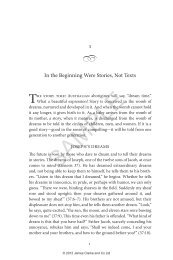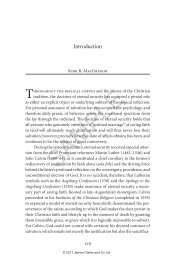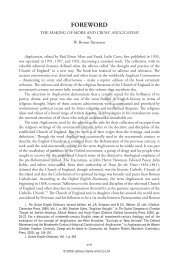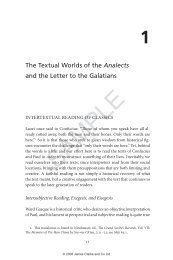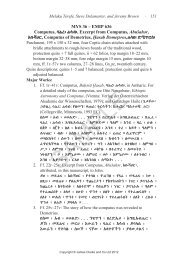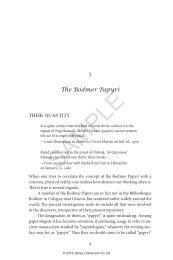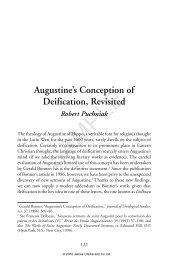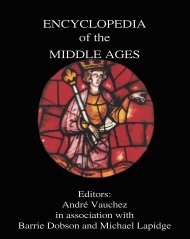The Liturgical Use of Psalm 29 - James Clarke and Co Ltd
The Liturgical Use of Psalm 29 - James Clarke and Co Ltd
The Liturgical Use of Psalm 29 - James Clarke and Co Ltd
Create successful ePaper yourself
Turn your PDF publications into a flip-book with our unique Google optimized e-Paper software.
8<br />
<strong>The</strong> <strong>Liturgical</strong> <strong>Use</strong> <strong>of</strong> <strong>Psalm</strong> <strong>29</strong><br />
Bert Polman<br />
As this volume demonstrates, the scholarly literature on<br />
<strong>Psalm</strong> <strong>29</strong> is extensive <strong>and</strong> based on a large body <strong>of</strong> psalm studies from<br />
the previous half-century. Scholars such as Mitchell Dahood, Peter<br />
Craigie <strong>and</strong> Carola Kloos have focused on the relationship between<br />
the biblical text <strong>of</strong> <strong>Psalm</strong> <strong>29</strong> <strong>and</strong> other ancient Near Eastern texts,<br />
especially those from the Canaanite region into which the Hebrews<br />
settled after their exodus from Egypt. <strong>The</strong> highly symmetrical use <strong>of</strong><br />
the terms “Lord” <strong>and</strong> the “voice <strong>of</strong> the Lord” in this psalm has fascinated<br />
scholars for years. David Noel Freedman <strong>and</strong> C. Franke-Hyl<strong>and</strong><br />
are representatives <strong>of</strong> those who have put this psalm text through a<br />
rigorous structural poetic analysis, while Pieter M. Venter, more recently,<br />
updates such an analysis with special attention to the physical<br />
<strong>and</strong> symbolic places mentioned in the body <strong>of</strong> the psalm. Less attention<br />
has been paid to the liturgical functions <strong>of</strong> <strong>Psalm</strong> <strong>29</strong> in the Judeo-<br />
Christian tradition <strong>and</strong> it is this latter topic that is the focus <strong>of</strong> this<br />
specific chapter. How was <strong>and</strong> is <strong>Psalm</strong> <strong>29</strong> used in Jewish worship past<br />
<strong>and</strong> present? And how do the various Christian traditions (Eastern<br />
Orthodox, Roman Catholic <strong>and</strong> Protestant) make use <strong>of</strong> this psalm<br />
text in traditional <strong>and</strong> contemporary worship?<br />
SAMPLE<br />
<strong>Psalm</strong> <strong>29</strong> in Jewish Worship<br />
Numerous scholars have categorized <strong>Psalm</strong> <strong>29</strong> as a victory hymn,<br />
analogous to the Song <strong>of</strong> the Sea (Exod 15:1–18; also called the Song<br />
<strong>of</strong> Moses), the Song <strong>of</strong> Deborah (Judg 5) <strong>and</strong> the Song <strong>of</strong> Hannah<br />
(1 Sam 2:1–10). Are these early song examples from the Book <strong>of</strong> the Wars<br />
90<br />
© 2011 <strong>James</strong> <strong>Clarke</strong> <strong>and</strong> <strong>Co</strong> <strong>Ltd</strong>
<strong>The</strong> <strong>Liturgical</strong> <strong>Use</strong> <strong>of</strong> <strong>Psalm</strong> <strong>29</strong><br />
91<br />
<strong>of</strong> the Lord mentioned in Numbers 21:14? And was <strong>Psalm</strong> <strong>29</strong> actually<br />
initially a part <strong>of</strong> that otherwise virtually unknown collection? Why was<br />
the Exodus 15 hymn not incorporated into the Book <strong>of</strong> <strong>Psalm</strong>s? Were<br />
such songs used in the Tabernacle during the Hebrew desert travels, or<br />
at least prior to the installation <strong>of</strong> temple worship in Jerusalem? <strong>The</strong>se<br />
are fascinating questions, but they remain unanswered <strong>and</strong> unanswerable<br />
given the absence <strong>of</strong> sufficient details.<br />
Equally evocative, but also inconclusive for the question <strong>of</strong> how<br />
<strong>Psalm</strong> <strong>29</strong> was used in early Jewish worship, is the relationship between<br />
the Hebrew text <strong>of</strong> this psalm <strong>and</strong> that <strong>of</strong> other ancient Near Eastern<br />
texts. Carola Kloos argued that the Hebrew God YHWH was assigned<br />
the traits <strong>of</strong> the Canaanite god Baal from earliest times, as in well before<br />
the prophets’ denouncements <strong>of</strong> the Baal religion (Kloos, 124). This<br />
could presume an early dating for <strong>Psalm</strong> <strong>29</strong>. However, Craigie claims<br />
that this psalm is strongly polemical, presumably contemporary with<br />
the later Hebrew prophets’ attack against Baal. He suggests that <strong>Psalm</strong> <strong>29</strong><br />
not only affirms YHWH as the Lord <strong>of</strong> nature <strong>and</strong> <strong>of</strong> the natural forces<br />
otherwise attributed to Baal, but that the text actually mocks those Baal<br />
powers (Craigie, 249). As the geographic origin <strong>of</strong> this psalm text is<br />
thought to be northern Canaan (given its references to Lebanon <strong>and</strong><br />
Sirion [Mount Hermon]), there are speculations that the psalm may<br />
have its antecedents or analogues in Baal worship at Dan which was<br />
located just south <strong>of</strong> Mount Hermon in northern Canaan, but that this<br />
text was written or adapted for use in the orthodox worship <strong>of</strong> YHWH<br />
in Jerusalem’s temple, possibly under the prodding <strong>of</strong> a “righteous” king<br />
such as Hezekiah or Josiah.<br />
Equally elusive is the conjecture that <strong>Psalm</strong> <strong>29</strong> was used in a specific<br />
festival in the practices <strong>of</strong> Judean pre-Jewish worship related in the<br />
Hebrew Bible. <strong>The</strong> great form-critical scholars <strong>of</strong> the psalms, Hermann<br />
Gunkel <strong>and</strong> Sigmund Mowinckel had proposed an Autumn Festival<br />
or an Enthronement Festival in which they located the Sitz im Leben<br />
(“situation in life”) <strong>of</strong> many psalms in the cultic rituals <strong>and</strong> festivals<br />
<strong>of</strong> Judean worship. In their view <strong>Psalm</strong> <strong>29</strong> becomes a royal psalm in<br />
which YHWH is the king. Similarly, Arthur Weiser proposed an annual<br />
<strong>Co</strong>venant Festival in which he claims many <strong>of</strong> the psalms find their<br />
function; he suggests <strong>Psalm</strong> <strong>29</strong> is a “theophany” psalm that signaled<br />
the appearance <strong>of</strong> God at such a festival. While most modern scholars<br />
<strong>of</strong> the psalms readily admit their pr<strong>of</strong>ound debt to these form-critical<br />
SAMPLE<br />
© 2011 <strong>James</strong> <strong>Clarke</strong> <strong>and</strong> <strong>Co</strong> <strong>Ltd</strong>
92 <strong>Psalm</strong> <strong>29</strong> through Time <strong>and</strong> Tradition<br />
scholars, there is a growing consensus that the evidence for such specific<br />
festivals is either exaggerated or certainly elusive <strong>and</strong> thus that any<br />
role that <strong>Psalm</strong> <strong>29</strong> may have had in such presupposed Enthronement or<br />
<strong>Co</strong>venant festivals is highly conjectural.<br />
<strong>The</strong> Greek translation <strong>of</strong> the Hebrew Bible by the “Seventy” (thus<br />
LXX, or “Septuagint”) adds a phrase to <strong>Psalm</strong> <strong>29</strong>’s customary superscription,<br />
“a psalm <strong>of</strong> David,” concerning “the conclusion <strong>of</strong> Tabernacles.”<br />
Various early Talmudic commentaries show that <strong>Psalm</strong> <strong>29</strong> was allied to<br />
the Feast <strong>of</strong> Tabernacles, Sukkot, either as one <strong>of</strong> the psalm readings for<br />
the opening <strong>of</strong> this autumn harvest festival or for use on the last day <strong>of</strong><br />
this festival, typically sung at the dramatic moment in the service when<br />
the Torah scroll is returned to the Ark after the congregation has read<br />
from it. Sukkot celebrations focus on thanksgiving for the harvest (<strong>and</strong><br />
by extension, how God took care <strong>of</strong> his people during their desert journey),<br />
<strong>and</strong> include prayers for rain (for which the thunderstorm in <strong>Psalm</strong><br />
<strong>29</strong> fits well). <strong>The</strong> seven occurrences <strong>of</strong> the “voice <strong>of</strong> the Lord” in the<br />
body <strong>of</strong> the psalm are thought to correspond to the pouring <strong>of</strong> water on<br />
the seventh day <strong>of</strong> this feast, to the seven-day length <strong>of</strong> this event, <strong>and</strong> to<br />
the seven processions around the altar that occur during this time. <strong>The</strong><br />
Septuagint’s addition <strong>of</strong> “the Tabernacles” phrase presumably reflects<br />
contemporary Jewish practices <strong>of</strong> the Second Temple up to the time<br />
<strong>of</strong> its destruction in 70 CE. One may conjecture that Jesus would have<br />
been familiar with the use <strong>of</strong> <strong>Psalm</strong> <strong>29</strong> during his participation in the<br />
Feast <strong>of</strong> Tabernacles as recorded in John 7. While various Jewish sources<br />
attest to the use <strong>of</strong> <strong>Psalm</strong> <strong>29</strong> during the autumn Feast <strong>of</strong> Tabernacles,<br />
the important S<strong>of</strong>erim treatise (±600 CE) assigns <strong>Psalm</strong> <strong>29</strong> to the late<br />
spring Festival <strong>of</strong> Weeks, Shavuot or Pentecost (Elbogen, 115), which<br />
is the earlier <strong>of</strong> the two big harvest festivals. It is this Shavuot tradition<br />
which the great eleventh-century Rabbi Solomon ben Isaac (known as<br />
Rashi) follows when he interprets psalm <strong>29</strong> with reference to the giving<br />
<strong>of</strong> the law by God to Moses, which is a central theme <strong>of</strong> Shavuot;<br />
however, he makes no reference to the Feast <strong>of</strong> Tabernacles (Solomon<br />
ben Isaac, 150–52).<br />
Modern Jewish use <strong>of</strong> <strong>Psalm</strong> <strong>29</strong> continues in the annual Feast<br />
<strong>of</strong> Tabernacles <strong>and</strong> in the weekly Kabbalat Shabbat (“Welcome to the<br />
Sabbath”) which occurs each Friday in the late afternoon or around<br />
sundown as a precursor to the regular Friday evening service. <strong>The</strong><br />
Kabbalat Shabbat service originated among Jewish mystics or kabbal-<br />
SAMPLE<br />
© 2011 <strong>James</strong> <strong>Clarke</strong> <strong>and</strong> <strong>Co</strong> <strong>Ltd</strong>
<strong>The</strong> <strong>Liturgical</strong> <strong>Use</strong> <strong>of</strong> <strong>Psalm</strong> <strong>29</strong><br />
93<br />
ists in the sixteenth-century. <strong>The</strong> contents <strong>of</strong> this service varies from<br />
one region <strong>and</strong>/or style <strong>of</strong> Judaism to another (Sephardic, Ashkenazic,<br />
Orthodox, Reform), but it is common for this part <strong>of</strong> the normal synagogue<br />
service to involve the readings <strong>of</strong> <strong>Psalm</strong>s 95–99 <strong>and</strong> <strong>Psalm</strong> <strong>29</strong>.<br />
<strong>The</strong>se royal psalms emphasize the reign <strong>of</strong> the Lord <strong>and</strong> the six psalms<br />
together are thought to correspond to the six days <strong>of</strong> creation or to the<br />
six weekdays.<br />
Among the usual components <strong>of</strong> the evening [maariv] or morning<br />
[shacharit] services are the Shema (Deut 6:4), with its blessings <strong>of</strong> creation,<br />
revelation <strong>and</strong> redemption; the series <strong>of</strong> Amidah prayers (which<br />
can be as many as eighteen “Benedictions,” the first three <strong>of</strong> which are<br />
related to phrases in <strong>Psalm</strong> <strong>29</strong>; the mourner’s Kaddish; <strong>and</strong> several<br />
songs, including the famous kabbalists’ hymn, Lekhah Dodi (“<strong>Co</strong>me,<br />
My Friend”) which welcomes the Sabbath as a bride. In addition, all <strong>of</strong><br />
<strong>Psalm</strong> <strong>29</strong>, or the “voice <strong>of</strong> the Lord” segments there<strong>of</strong>, are <strong>of</strong>ten featured<br />
during the processing <strong>of</strong> the Torah in conjunction with the reading <strong>of</strong><br />
the Jewish Scriptures.<br />
<strong>Psalm</strong> <strong>29</strong> [28] in Eastern Orthodox Worship<br />
<strong>The</strong> many translations into vernacular languages <strong>of</strong> the book <strong>of</strong> <strong>Psalm</strong>s<br />
used in Eastern Orthodox Christian services derive from the Septuagint<br />
Greek translation. Since the Septuagint used a slightly different numbering<br />
system than the Hebrew Bible, <strong>Psalm</strong> <strong>29</strong> in the Hebrew text is <strong>Psalm</strong><br />
28 in most Bible versions used in the Eastern Orthodox churches. In the<br />
following section on Orthodox liturgy “<strong>Psalm</strong> <strong>29</strong>” will be used in conformity<br />
with the Hebrew <strong>and</strong> Protestant Bibles numbering system; however,<br />
in the Orthodox traditions themselves this psalm is numbered “28.”<br />
As in Jewish tradition it is customary that portions <strong>of</strong> <strong>Psalm</strong> <strong>29</strong> are<br />
used as psalm versicles [prokeimena] in the Divine Liturgy <strong>and</strong> in the<br />
Matins <strong>of</strong> the Orthodox Church. Most common are verse 1: “Ascribe to<br />
the Lord . . .”; verse 3: “<strong>The</strong> voice <strong>of</strong> the Lord is over the waters . . .”; <strong>and</strong><br />
verse 11: “<strong>The</strong> Lord will give strength to his people . . .” Such versicles<br />
usually precede the reading <strong>of</strong> a portion <strong>of</strong> Scripture <strong>and</strong> function much<br />
in the same way as the gradual does in the Roman Catholic mass.<br />
But the most notable place for <strong>Psalm</strong> <strong>29</strong> in Orthodoxy occurs<br />
during the “Great Blessing <strong>of</strong> Water” (megas agiasmos), which is part<br />
<strong>of</strong> the Feast <strong>of</strong> <strong>The</strong>ophany or Epiphany. Since the early period <strong>of</strong> the<br />
SAMPLE<br />
© 2011 <strong>James</strong> <strong>Clarke</strong> <strong>and</strong> <strong>Co</strong> <strong>Ltd</strong>
94 <strong>Psalm</strong> <strong>29</strong> through Time <strong>and</strong> Tradition<br />
church, Eastern Orthodoxy celebrated the baptism <strong>of</strong> Jesus on the day<br />
<strong>of</strong> Epiphany, January 6. That festival commemorates the manifestation<br />
<strong>of</strong> the Holy Trinity in that baptismal event: God the Father spoke “this<br />
is my Son” as Christ was baptized by John in the Jordan River during<br />
which time the Holy Spirit was symbolized by a dove descending on<br />
Jesus. Orthodox liturgy does not only emphasize the Trinity in the feast,<br />
however, but also focuses on the sanctification <strong>of</strong> water by the Spirit <strong>of</strong><br />
God as explained by such church fathers as Saints Basil <strong>and</strong> Ambrose.<br />
According to Orthodox theology all creation is sanctified in Christ’s<br />
baptism <strong>and</strong> thus it is fitting that a creation psalm such as <strong>Psalm</strong> <strong>29</strong>, with<br />
its imagery <strong>of</strong> a storm, is an important part <strong>of</strong> the liturgy <strong>of</strong> Epiphany.<br />
<strong>The</strong> “Great Blessing <strong>of</strong> Water” is held on the eve <strong>of</strong> the Feast <strong>of</strong> the<br />
Epiphany, during the “third royal hour” <strong>and</strong> has roots that date back<br />
to the compilation work <strong>of</strong> Saint Sophronius (560–638), who was the<br />
Patriarch <strong>of</strong> Jerusalem in his final years. <strong>The</strong> liturgy consists <strong>of</strong> Isaiah 35<br />
<strong>and</strong> 55; 1 <strong>Co</strong>rinthians 10:1–4; Mark 1:9–11; <strong>Psalm</strong>s <strong>29</strong>, 42 [=41], <strong>and</strong> 51<br />
[=50]; <strong>and</strong> a number <strong>of</strong> prayers, including a special prayer for the sanctification<br />
<strong>of</strong> water by the Spirit <strong>of</strong> God. Because many more people are<br />
present for worship on the day <strong>of</strong> Epiphany, this service <strong>of</strong> the “Great<br />
Blessing <strong>of</strong> Water” is <strong>of</strong>ten repeated following the Divine Liturgy for<br />
Epiphany. After the solemn blessing the holy water is distributed to the<br />
church members for them to drink as a memorial <strong>of</strong> their own baptism<br />
<strong>and</strong> to be taken with them as blessing for their homes. With the words <strong>of</strong><br />
<strong>Psalm</strong> <strong>29</strong> ringing fresh in their ears, Orthodox Christians practice what<br />
Saint John Chrysostom (347–407) taught in a sermon on the Epiphany:<br />
“For this is the day on which he was baptized <strong>and</strong> sanctified the nature<br />
<strong>of</strong> the waters. Hence for this reason during this feast at midnight we<br />
all, having drawn the water, deposit the streams at home <strong>and</strong> we keep<br />
it there for a whole year, in as much as it was on this day that the waters<br />
were sanctified.” [In homiliam de baptismo Christi et de epiphania 2<br />
[Migne PG 49.365–66], translated by Margaret M. Mitchell).<br />
SAMPLE<br />
<strong>Psalm</strong> <strong>29</strong> in Western Christianity<br />
As noted, the Eastern Church celebrates the baptism <strong>of</strong> Jesus on the<br />
Feast <strong>of</strong> the Epiphany. By contrast, the Western Church observes the<br />
coming <strong>of</strong> the Magi on Epiphany <strong>and</strong> celebrates the Baptism <strong>of</strong> the<br />
Lord on the Sunday after Epiphany. Also, note that the Vulgate Bible was<br />
© 2011 <strong>James</strong> <strong>Clarke</strong> <strong>and</strong> <strong>Co</strong> <strong>Ltd</strong>
<strong>The</strong> <strong>Liturgical</strong> <strong>Use</strong> <strong>of</strong> <strong>Psalm</strong> <strong>29</strong><br />
95<br />
based on the Septuagint <strong>and</strong> until modern times the Catholic Church<br />
has, like Orthodoxy, numbered <strong>Psalm</strong> <strong>29</strong> as <strong>Psalm</strong> 28; the most modern<br />
English Catholic Bibles have, however, adopted the Hebrew Bible numbering<br />
system.<br />
While the medieval church in the west also assigned <strong>Psalm</strong> <strong>29</strong> to<br />
the service that focused on the baptism <strong>of</strong> Christ during the Epiphany<br />
season, it is the weekly chanting <strong>of</strong> this psalm that st<strong>and</strong>s out in the<br />
medieval Roman Catholic tradition. In the monastic breviary (that<br />
is: the liturgy book <strong>of</strong> the daily Offices) <strong>of</strong> the later medieval times,<br />
<strong>Psalm</strong> <strong>29</strong> is one <strong>of</strong> a dozen psalms appointed to Matins for each Sunday<br />
morning in the ferial psalter, that is for ordinary week-days, not during<br />
the festive seasons (Harper, 259). In the ferial psalter for use outside<br />
<strong>of</strong> monastic institutions (for secular use), <strong>Psalm</strong> <strong>29</strong> appears among the<br />
psalms appointed for Matins <strong>of</strong> each Monday morning (Harper, 258).<br />
Reforms <strong>of</strong> the breviary in the sixteenth-century, in 1911 under Pope<br />
Pius X, <strong>and</strong> following the Second Vatican <strong>Co</strong>uncil <strong>of</strong> the 1960s have<br />
produced changes in which psalms are assigned to which <strong>of</strong> the daily<br />
Offices, but the practice <strong>of</strong> reading or chanting the entire psalter in a<br />
week has continued largely unabated. Imagine singing <strong>Psalm</strong> <strong>29</strong> once a<br />
week throughout a person’s entire adult lifetime!<br />
Judiciously adopting <strong>and</strong> adapting various Roman Catholic <strong>and</strong><br />
some Lutheran sources, Thomas Cranmer prepared the Book <strong>of</strong> <strong>Co</strong>mmon<br />
Prayer for the young Anglican Church in 1549. Ab<strong>and</strong>oning the weekly<br />
singing <strong>of</strong> the psalms during the eight daily Offices, he assigned the entire<br />
psalter to a monthly cycle, divided between Matins <strong>and</strong> Evensong.<br />
<strong>Psalm</strong> <strong>29</strong> was the third psalm appointed to Evensong on the fifth day<br />
<strong>of</strong> each month, following <strong>Psalm</strong>s 27 <strong>and</strong> 28 (Harper, 265). <strong>The</strong> order <strong>of</strong><br />
singing the psalms in the 1549 Book <strong>of</strong> <strong>Co</strong>mmon Prayer was retained<br />
in the tables in the 1552, 1559, <strong>and</strong> 1662 editions, <strong>and</strong> survives largely<br />
unchanged in modern versions <strong>of</strong> the Book <strong>of</strong> <strong>Co</strong>mmon Prayer. <strong>The</strong><br />
various prayer-books that are used in Anglican churches world-wide<br />
today contain similar charts that promote this practice <strong>of</strong> singing all<br />
the psalms every month, including <strong>Psalm</strong> <strong>29</strong> in its appointed sequence.<br />
John Calvin’s emphasis on congregational singing <strong>of</strong> psalms produced<br />
the “Genevan” Psalter in 1562: Les <strong>Psalm</strong>es mis en rime françoise<br />
par Clement Marot et <strong>The</strong>odore de Beze. Various charts are available<br />
from Calvin’s church in Geneva which show the psalms, paraphrased<br />
in French, assigned to be sung on Sunday mornings <strong>and</strong> evenings <strong>and</strong><br />
at Wednesday prayer meetings. <strong>The</strong> 1549 chart, when the “Genevan”<br />
SAMPLE<br />
© 2011 <strong>James</strong> <strong>Clarke</strong> <strong>and</strong> <strong>Co</strong> <strong>Ltd</strong>
96 <strong>Psalm</strong> <strong>29</strong> through Time <strong>and</strong> Tradition<br />
Psalter was still incomplete, covers some 50 psalms on a 17-week cycle<br />
<strong>and</strong> does not contain <strong>Psalm</strong> <strong>29</strong>. <strong>Psalm</strong> <strong>29</strong> does appear on the 1553 chart<br />
that covers 83 psalms on a 28-week rotation; it is assigned there for<br />
Sunday evenings in the sixth week. Upon completion <strong>of</strong> the “Genevan”<br />
Psalter, the 1562 chart covers all 150 psalms on a 25-week cycle. In it<br />
<strong>Psalm</strong> <strong>29</strong> is now appointed to be sung early Sunday mornings (“at the<br />
ringing <strong>of</strong> the second bell”) in each third week <strong>of</strong> this semi-annual rotation<br />
(Pidoux, 2.135).<br />
<strong>The</strong> various Kirchenordnung (church order) documents <strong>of</strong> early<br />
Lutheranism appointed psalms to be sung in Latin or German for<br />
Matins <strong>and</strong> Vespers. Early Methodists tended to use the order <strong>of</strong> psalms<br />
assigned in the Book <strong>of</strong> <strong>Co</strong>mmon Prayer. Without monastic institutions,<br />
however, only the Offices <strong>of</strong> Matins <strong>and</strong> Vespers, with their respective<br />
repertory <strong>of</strong> psalms, have prevailed among Protestant Christians<br />
<strong>and</strong> certainly not uniformly among them. While some local churches<br />
faithfully continue the practice <strong>of</strong> morning <strong>and</strong> evening Offices for the<br />
h<strong>and</strong>ful <strong>of</strong> people who come for such corporate daily worship, for many<br />
Christians the daily Offices have become simplified to their personal or<br />
family devotions. To that end various modern prayer-books <strong>and</strong> hymnals<br />
include charts <strong>and</strong> assign the psalms to be read daily at home, in<br />
various sequences, as a domestic or personal imitation <strong>of</strong> the traditional<br />
ordering <strong>of</strong> singing the psalms in corporate daily worship at church or<br />
monastery/convent. Any Christian who accepts that discipline <strong>of</strong> daily<br />
devotion will be confronted regularly with “the voice <strong>of</strong> the Lord” as<br />
<strong>Psalm</strong> <strong>29</strong> purports.<br />
SAMPLE<br />
<strong>Psalm</strong> <strong>29</strong> in the Modern Ecumenical Lectionary <strong>of</strong> the<br />
West<br />
Following the Second Vatican <strong>Co</strong>uncil, the Roman Catholic Church<br />
produced a new lectionary in 1969. It was soon adopted <strong>and</strong> altered<br />
by Presbyterians, Anglicans, <strong>and</strong> Lutherans, as well as adopted for trial<br />
use in several other denominations in North America <strong>and</strong>, to a lesser<br />
extent, in other English-speaking countries. A process towards lectionary<br />
consensus was begun in 1978 by the <strong>Co</strong>nsultation on <strong>Co</strong>mmon<br />
Texts. This resulted in the three-year <strong>Co</strong>mmon Lectionary, published in<br />
1983. After two cycles <strong>of</strong> use <strong>and</strong> many suggestions <strong>and</strong> criticisms, <strong>The</strong><br />
Revised <strong>Co</strong>mmon Lectionary was issued in 1992. Though <strong>The</strong> Revised<br />
© 2011 <strong>James</strong> <strong>Clarke</strong> <strong>and</strong> <strong>Co</strong> <strong>Ltd</strong>
<strong>The</strong> <strong>Liturgical</strong> <strong>Use</strong> <strong>of</strong> <strong>Psalm</strong> <strong>29</strong><br />
97<br />
<strong>Co</strong>mmon Lectionary is a widely accepted ecumenical text, there are still<br />
minor differences between <strong>The</strong> Revised <strong>Co</strong>mmon Lectionary <strong>and</strong> the actual<br />
lectionary systems that prevail among Roman Catholics, Anglicans,<br />
Lutherans, Presbyterians, <strong>and</strong> Methodists.<br />
<strong>The</strong> Revised <strong>Co</strong>mmon Lectionary includes 105 psalms <strong>and</strong> 10 canticles<br />
as the responses to the first reading for each Sunday <strong>and</strong> feastday,<br />
which is typically an Old Testament reading. As was noted in the<br />
descriptions above for the association <strong>of</strong> <strong>Psalm</strong> <strong>29</strong> with the baptism <strong>of</strong><br />
Jesus, <strong>The</strong> Revised <strong>Co</strong>mmon Lectionary appoints <strong>Psalm</strong> <strong>29</strong> among the<br />
following readings for the Epiphany Sunday devoted to the Baptism <strong>of</strong><br />
the Lord:<br />
Year A: Isaiah 42:1–9; <strong>Psalm</strong> <strong>29</strong>; Acts 10:34–43; Matthew 3:13–17<br />
Year B: Genesis 1:1–5; <strong>Psalm</strong> <strong>29</strong>; Acts 19:1–7; Mark 1:4–11<br />
Year C: Isaiah 43:1–17; <strong>Psalm</strong> <strong>29</strong>; Acts 8:14–17; Luke 3:15–17,<br />
21–22<br />
In addition, <strong>Psalm</strong> <strong>29</strong> is assigned to Trinity Sunday in Year B in <strong>The</strong><br />
Revised <strong>Co</strong>mmon Lectionary; the usage <strong>of</strong> this psalm for the Trinity<br />
Festival was inherited from earlier Anglican traditions, though the relationship<br />
<strong>of</strong> <strong>Psalm</strong> <strong>29</strong> to the Feast <strong>of</strong> Trinity is clearly rooted in Eastern<br />
Orthodoxy’s ancient emphasis on the Trinity at the baptism <strong>of</strong> Jesus.<br />
<strong>Co</strong>nclusion<br />
SAMPLE<br />
<strong>Psalm</strong> <strong>29</strong> continues to hold an important place in both Jewish <strong>and</strong><br />
Christian liturgies. Select portions <strong>of</strong> this psalm have found their appointed<br />
places in a variety <strong>of</strong> worship orders. <strong>The</strong> entire psalm has an<br />
honored place in the Jewish Feast <strong>of</strong> Tabernacles (Sukkot) <strong>and</strong> in the<br />
various Christian celebrations <strong>of</strong> the baptism <strong>of</strong> Jesus. And thus, “the<br />
voice <strong>of</strong> the Lord” continues to sound “upon the waters.”<br />
© 2011 <strong>James</strong> <strong>Clarke</strong> <strong>and</strong> <strong>Co</strong> <strong>Ltd</strong>
98 <strong>Psalm</strong> <strong>29</strong> through Time <strong>and</strong> Tradition<br />
Bibliography<br />
Craigie, Peter C. <strong>Psalm</strong>s 1–50. WBC 19. Waco, TX: Word, 1983.<br />
Dahood, Mitchell. <strong>Psalm</strong>s I: 1–50. AB 16. Garden City, NY: Doubleday, 1966.<br />
Elbogen, Ismar. Jewish Liturgy: A <strong>Co</strong>mprehensive History. Translated by Raymond P.<br />
Scheindlin. Philadelphia: Jewish Publication Society, 1993.<br />
Farrow, Michael G. <strong>Psalm</strong>s Verses <strong>of</strong> the Orthodox Liturgy: According to the Greek <strong>and</strong><br />
Slav Usages. Torrance, CA: Oakwood, 1997.<br />
Ferguson, Everett. “Preaching at Epiphany: Gregory <strong>of</strong> Nyssa <strong>and</strong> John Chrysostom<br />
on Baptism <strong>and</strong> the Church.” CH 66 (1997) 1–17.<br />
Freedman, David Noel, <strong>and</strong> C. Franke Hyl<strong>and</strong>. “<strong>Psalm</strong> <strong>29</strong>: A Structural Analysis.” HTR<br />
66 (1973) 237–56.<br />
Harper, John. <strong>The</strong> Forms <strong>and</strong> Orders <strong>of</strong> Western Liturgy. Oxford: Clarendon, 1991.<br />
Kloos, Carola. YHWH’s <strong>Co</strong>mbat with the Sea: A Canaanite Tradition in the Religion <strong>of</strong><br />
Ancient Israel. Leiden: Brill, 1986.<br />
Kraus, Hans-Joachim. <strong>Psalm</strong>s 1–59: A <strong>Co</strong>mmentary. Translated by Hilton C. Oswald.<br />
<strong>Co</strong>ntinental <strong>Co</strong>mmentaries. Minneapolis: Augsburg, 1988.<br />
Pidoux, Pierre. Le Psautier Huguenot de XVIe Siecle. Vol. 2. Basel: Baerenreiter, 1962.<br />
<strong>The</strong> Revised <strong>Co</strong>mmon Lectionary. Winfield, BC: Wood Lake, 1992.<br />
Solomon ben Isaac. Rashi’s <strong>Co</strong>mmentary on <strong>Psalm</strong>s 1–89 (Books I–III). Translated <strong>and</strong><br />
annotated by Mayer I. Gruber. SFSHJ 161. Atlanta: Scholars, 1998.<br />
Venter, Pieter M. “Spaciality in <strong>Psalm</strong> <strong>29</strong>.” In <strong>Psalm</strong>s <strong>and</strong> Liturgy, edited by Dirk J.<br />
Human <strong>and</strong> Cas J. A. Vos, 235–50. JSOTSup 410. London: T. & T. Clark, 2004.<br />
SAMPLE<br />
© 2011 <strong>James</strong> <strong>Clarke</strong> <strong>and</strong> <strong>Co</strong> <strong>Ltd</strong>





